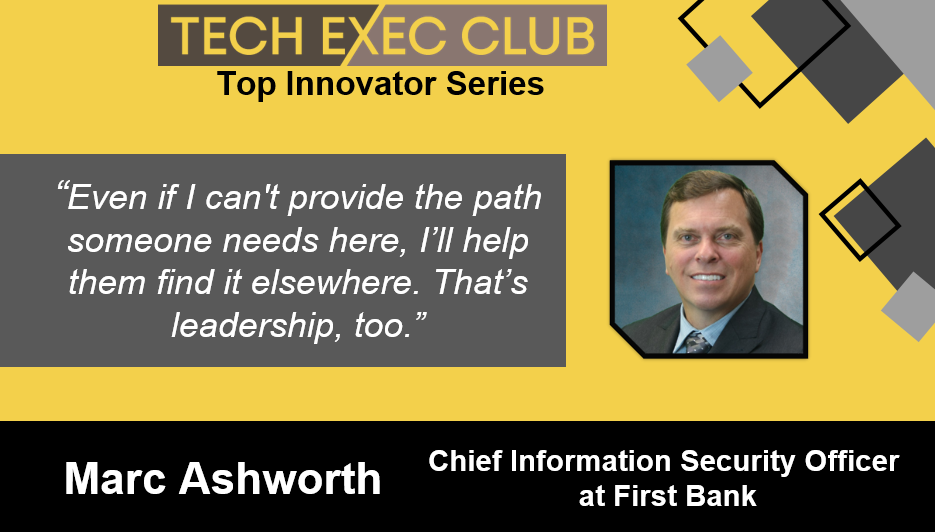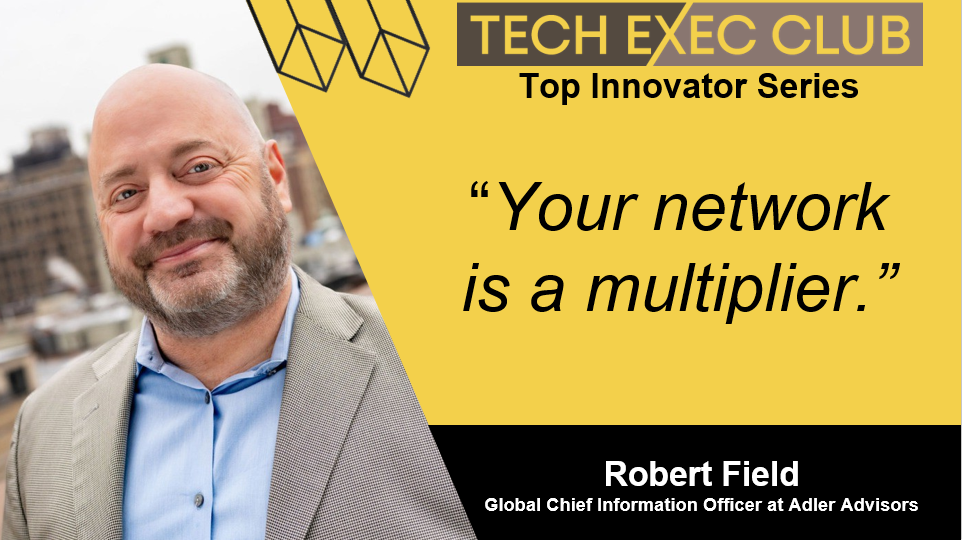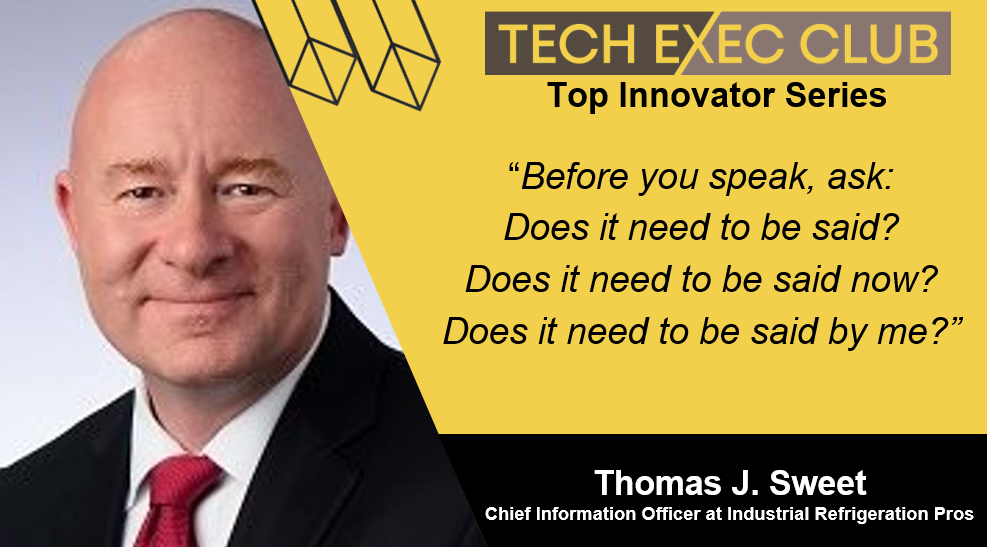In a world where the pace of technology accelerates daily, and threats loom more significant with every line of code, leadership in cybersecurity is no longer just about technical prowess—it’s about connection, empathy, and vision. Few exemplify that balance better than Marc Ashworth, Chief Information Security Officer (CISO) at a Missouri-based family-owned bank and host of the widely-followed podcast The Cyber Executive. Named one of the “Top Five CIOs Everyone Should Know” by CIO Times, Ashworth has become a standout figure for his technical mastery and human-centered leadership style.
In this exclusive interview with Josef Martens, founder of the Tech Executive Club and host of the Top Innovator Series, Ashworth opens up about his path to leadership, the mentors who shaped him, and the quiet power of one-on-one conversations in the digital age. He reflects on his journey and what it takes to lead teams through transformation—not with force, but with empathy, resilience, and authenticity.
From goal-setting frameworks like Stephen Covey’s “WIGs” to the underrated art of truly listening to your team, Ashworth shares the leadership philosophies that propelled him from a hotel industry part-timer in college to a cybersecurity leader influencing thousands.
And yet, he’s not done. Whether through advisory board work, public speaking, or mentoring future leaders, Ashworth continues to shape the future of tech leadership—one authentic conversation at a time.
Empathy-Driven Leadership: Learning from People, Not Just Managing Them
For Marc Ashworth, leadership isn’t a command-and-control structure—it’s a two-way street. One of the defining characteristics of his approach is an unwavering commitment to empathy and human connection. This mindset didn’t originate in a cybersecurity course or leadership workshop—it was born in the hospitality industry, where Ashworth worked during college. Dealing with customers taught him a simple truth: people remember how you make them feel, not just what you do.
That lesson followed him throughout his career. As he climbed the ranks in tech and security roles, Ashworth found that the most effective leaders weren’t those who dictated direction but those who nurtured growth. His bosses modeled this kind of leadership—leaders who listened, understood, and helped him grow without micromanagement. It’s a legacy he now pays forward.
“I’m just trying to help others succeed in what they’re doing,” Ashworth says. “If I can help someone become the next leader—or learn from them myself—then we’re doing something right.”
He sees leadership as mutual mentorship, where both the leader and the team learn from each other. This approach has become the bedrock of his leadership style and the reason his teams not only perform but thrive.
Turning Inspiration into Action: Goal-Setting Frameworks that Drive Growth
Many leaders dabble in motivational literature, but Marc Ashworth doesn’t just read it—he integrates it into his leadership philosophy. Influenced by thought leaders like Stephen Covey, Zig Ziglar, and Brian Tracy, Ashworth has adopted tools like Wildly Important Goals (WIGs) to create structure, drive focus, and elevate team performance.
“Covey talks about WIGs—setting just a few critical goals that matter most,” Ashworth explains. “We’ve used that for years, and it helps individuals and teams concentrate on what moves the needle.”
But Ashworth isn’t rigid about these frameworks. He understands that flexibility is essential, especially in fast-paced environments. Some teams thrive with just two to three goals; others, dealing with smaller tasks, may need four or five. The point isn’t the number—it’s the clarity and commitment.
He pairs WIGs with more strategic, monthly systems like the Four Blocks. This dual approach helps his teams stay aligned with the broader business objectives while making incremental progress.
“Setting goals is one thing,” he says. “Getting people to own them is where the magic happens.”
By blending structure with adaptability, Ashworth helps his team stay focused without feeling boxed in—proving that leadership is as much about clarity as compassion.
The Power of Visibility: Building Influence Beyond the Office Walls
In an age where influence often extends beyond internal meetings and email chains, Marc Ashworth understands the power of visibility. Ashworth has built a personal brand rooted in thought leadership with over 8,000 LinkedIn followers, regular keynote speaking engagements, and a growing podcast called The Cyber Executive.
But this isn’t just about personal recognition. It’s a strategic extension of his leadership philosophy that helps spread awareness about cybersecurity, inspire others in the industry, and bring credibility to the teams he leads.
“I enjoy getting the word out about cybersecurity and leadership,” he says. “And I guess people like to hear what I have to say.”
Ashworth’s visibility is also a recruitment and retention tool. When people see leaders actively engaged in the broader industry, they’re more likely to want to work with and learn from them. It’s a subtle but powerful message: this is a leader who not only talks about innovation—but lives it.
As his influence grows, so does his ability to advocate for business-aligned security practices, challenge outdated thinking, and bring real-world experience into executive conversations.
For Ashworth, visibility isn’t vanity—it’s value. It’s how a leader’s impact multiplies beyond their immediate circle, shaping an industry one podcast, post, or panel at a time.
One-on-One Conversations: The Underrated Superpower in Tech Leadership
When everything else feels unraveling—when strategies stall, projects hit bottlenecks or morale dips—Marc Ashworth has a simple, timeless solution: the one-on-one conversation.
“If nothing else is working, I go back to the basics,” he says. “Sit down with someone and talk. What are you trying to achieve? How can I help you get there?”
This is more than just a managerial check-in—it’s a personal dialogue built on trust and curiosity. Ashworth believes that too often, companies try to solve performance issues with more processes, policies, and pressure. But sometimes, a team member needs to feel heard, understood, and supported.
These conversations are also where absolute alignment happens. They provide space for both leader and employee to explore individual goals and organizational vision and where they intersect. And when they don’t align? Ashworth doesn’t shy away from helping people find new paths—even if that means guiding them toward opportunities outside the organization.
“If I can’t offer them what they need, I’ll help them take the next step elsewhere. That’s leadership, too.”
In a world obsessed with dashboards and metrics, Ashworth reminds us that real leadership often happens in quiet spaces—across the desk, in candid conversation, human-to-human.
Future Leadership and the Growth Mindset: What’s Next for Marc Ashworth
Despite his many accolades, Marc Ashworth remains strikingly grounded—and perpetually curious about what comes next. He firmly believes that leadership is a journey, not a destination.
Looking ahead, Ashworth sees his role evolving in two directions: more significant influence and profound contribution. Whether it’s expanding his podcast to feature more tech leaders, taking on advisory board roles, or mentoring up-and-coming executives, his next chapter is less about climbing and more about lifting others.
“Helping others grow—that’s where I get energy,” he says. “And there’s always something new to learn. That doesn’t stop.”
But he’s also honest about the obstacles leaders face today, especially in tech. Chief among them? Time.
“Time is the biggest challenge,” Ashworth notes. “You have to carve it out intentionally—for learning, mentorship, innovation.”
Still, he embraces the tension between growth and constraint. Whether in the boardroom or beyond, Ashworth is constantly evolving—sharpening his thinking, challenging his assumptions, and seeking new ways to contribute.
Even when retirement eventually comes, it won’t be the end. For Ashworth, it will simply be a new iteration of leadership—a life still rooted in purpose, connection, and curiosity.
Marc Ashworth’s leadership journey offers more than just inspiration—it provides practical takeaways that can elevate how you lead, influence, and grow in your organization or tech team. Here’s a detailed, itemized call to action based on his insights:
1. Lead with Empathy, Not Just Authority: Start with understanding before directing. Regularly check your team’s goals, personal challenges, and aspirations—not just KPIs. Practice empathetic listening to build trust and uncover hidden obstacles.
2. Implement Structured Goal-Setting Frameworks: Introduce tools like Stephen Covey’s “WIGs” (Wildly Important Goals) to help teams focus on what truly matters. Pair short-term objectives with larger monthly or strategic targets using methods like the Four Blocks. Tailor goal structures to team capacity—don’t force a rigid model.
3. Use One-on-One Conversations as Your Leadership Reset Button: When things feel stuck, return to the basics—personal conversations. Ask open-ended questions: “Where do you want to go?”, “What’s getting in your way?” “How can I support you?” Build a culture where these one-on-ones are not just reactive but have a regular leadership rhythm.
4. Expand Your Visibility and Influence: Share your knowledge through platforms like LinkedIn, podcasts, or speaking events. Use visibility not just for self-promotion but also to advocate for your team and ideas. Position yourself as a thought leader in your space—influence doesn’t happen in silence.
5. Build a Culture of Mutual Mentorship: Recognize that leadership is a two-way street—you learn as much from your team as they learn from you. Encourage peer learning and cross-functional mentorship across your organization. Be humble enough to learn from those you lead.
6. Embrace a Growth Mindset—For Yourself and Your Team: Set aside time for continuous learning and self-development, even when it feels inconvenient. Encourage team members to think beyond their current roles and help them see future leadership opportunities. Remember, growth doesn’t stop at the top—it evolves with you.
7. Redefine Leadership Success Beyond Titles: Consider ways to give back—through advisory boards, charitable organizations, or mentoring others in the industry. Think about your legacy not just in terms of results but also in terms of how you helped others grow. Understand that leadership doesn’t end with retirement—it simply evolves into new forms of contribution.
Marc Ashworth is more than a cybersecurity expert—he is a leader who bridges the gap between technology and humanity. With a career shaped by service, mentorship, and a relentless drive to help others grow, Ashworth exemplifies what the future of leadership should look like: thoughtful, empathetic, and deeply connected to the people behind the technology.
His journey from hotel lobbies to C-suite boardrooms is a testament to the power of leading with purpose—not just process. Whether he’s guiding a team through technical transformation, hosting thought leaders on his podcast The Cyber Executive, or sharing insights from the stage, Marc Ashworth leads with heart, humility, and a clear vision for a better, more human-centered tech culture.
As organizations navigate an increasingly complex world of digital threats and workplace challenges, leaders like Ashworth offer a compass that points toward connection, clarity, and continuous growth.
He may be one of the CIO Times’ Top Five CIOs Everyone Should Know, but after hearing his story, I have realized that Marc Ashworth is also a leader from whom everyone can learn.





